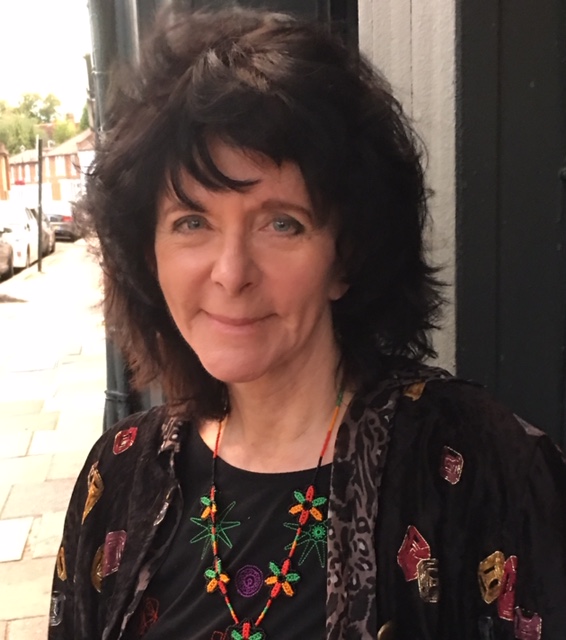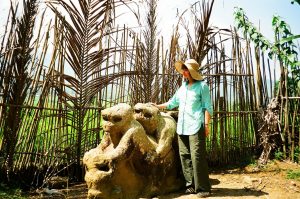
Ruth Padel
Art, Migration and Identity
Published in The Guardian Thursday 26 January 2012
http://www.guardian.co.uk/artanddesign/2012/jan/26/tate-britain-migrations-art-identity
Where does art start? People were at it on pots long before they carried pigments into their caves at Lascaux. Migrations, a startlingly original show at Tate Britain, will open up all sorts of new ways of seeing art as migration, as a continual flowing in from somewhere else. Its migrant nature begins when you translate what you’ve seen into what you make. You dream up wavy lines on a soup bowl in response to lines you’ve seen in the world, but later in response to what other people have made of the world. Influence is an unstoppable current. Seeing someone else’s stirrup jar, you put new whorls and ridges on your rhyton. Like languages, diseases and the alphabet, through trade, invasion or colonisation, art migrates. Artists pulled by hunger, politics, persecution, war or simply hope go where the work is. Art and migration belong together.
But migration and home belong together, too. They are two sides of the same coin. The Tate originally had a dual purpose, to house both British and modern art. With the advent of Tate Modern, this has had to be redefined. The Millbank site is now the home of British art, and Migrations tells a story of how migration shaped British art and repositions Tate Britain as the national gallery that best sums up our national identity: an identity still evolving, but which is also the residue of 1,500 years of immigration.
Migrations also, therefore, redraws the parameters for the larger question: what is British? In 1700, Daniel Defoe said of “true-born Englishmen”, “Fate jumbled them together, God knows how; / Whate’er they were, they’re True-Born English now,” and today’s Museum of Immigration at Spitalfields testifies to successive waves of immigrants who added to our genetic soup. Like “British” blood, many of the works in Tate Britain’s collection have in some sense come from somewhere else.

The book that accompanies the show, edited by curator Lizzie Carey-Thomas, is full of reflections on what migration and art mean today in Britain. A reminder that Britain before the 16th century was not entirely an artistic blank slate would have been useful, but this exhibition reflects the strengths in a collection whose starting-point is 1545, and it should change for ever how people talk about the history and identity of British art.
When Tate Britain’s new director, Penelope Curtis, arrived in 2009 she wanted, she says, to look at the collection “in relation to its troubling name”. At one level British art is simply (like British people) art that has ended up in Britain. At another, British art is international art. JMW Turner, one of our biggest international names, went abroad to meet his influences, travelled to France and Switzerland, studied at the Louvre. He is English, and so not in this show, but the prize created at Tate Britain in his name is open both to any artist living and working in Britain and British artists working abroad.
Migrations sees British art and identity as a 500-year dialogue with Europe, America, the Commonwealth and ex-colonies. Artists came for work; with them came new genres. Tate Britain’s earliest work is a portrait painted in 1545 by an Englishman, John Bettes. But Bettes was influenced (and overshadowed) by an internationally acclaimed German, Hans Holbein, King’s Painter to Henry VIII. It wasn’t until the 18th century that British-born portrait painters could compete with foreign incomers.
Bettes doesn’t get into this show because, like Turner, he’s English, and Tate Britain doesn’t have a Holbein. So the earliest paintings here are 1560s portraits by Bruges-born Marcus Gheeraerts, portraitist to Queen Elizabeth’s court. Landscape painting, as well as portraiture, seems quintessentially British, but both the idea and the name came from Holland and the Dutch word landschap. From still life to animal painting, allegorical and mythical narrative to seascapes, everything came from the continent, where artists were much better trained.
The curators have chosen work with good stories attached, but their big story is how migration shaped the way we see ourselves. An English Family at Tea, by the 18th-century Flemish artist Joseph Van Aken, is hilariously unrelaxed. Is that how continental Europeans saw us, how we wanted to be seen? The statuary, hand-on-hip poses, the almost autistic gaze of men who stare right away from everyone else and a woman pouring tea without looking emanate an authentically English, stiffly self-conscious disconnect from what is really going on.
But it is the relation of two other paintings that most dramatically sums up the way the migrations of art can question British identity. Portsmouth Dockyard was painted around 1877 by the French artist James Tissot. Like his friend Whistler (another incomer, from America), Tissot enjoyed painting water. For him, water was the site of human drama, choices and departures. Here, a Highland sergeant sits between two women in a skiff. Two ships behind echo the choice he is treacherously making as he turns from his plaid-shawled companion to a Renoir-ish lass lifting her face to his. In 1991, the Tanzanian-born artist Lubaina Himid reworked Tissot’s image in Between the Two My Heart Is Balanced. Himid got rid of the harbour setting and military male. Her women sit either side of a pile of papers – which possibly represent other lost migrants. “Two women in a small boat tearing up navigation charts,” Himid has explained. “How many died, crossing the water?”
Himid studied at Wimbledon Art School in the 1970s. In the 80s she was a key figure in Britain’s Black Art movement. In several paintings she uses pairs of black women to question history and the white male’s position in it. These women’s faces echo the angles of Tissot’s. So do the tones of the sea, pale on the left, dark on the right. But Himid’s women are alone on a rough, open sea that is even more resonant today as the numbers mount of would-be migrants from Africa who are drowned off Libya, Tenerife and Sicily in open boats just like this. Where are these women heading? Towards us, like Tissot’s trio. How does that make us feel?
Invited to consider Tate Britain’s whole collection through the prism of migration, Carey-Thomas wanted to make the experience of this show as fluid as possible. If you want to walk a chronological path, you can follow hundreds of years of our engagement with art, as Britain repositioned itself through portraits and landscape, neoclassicism and empire, founded the Royal Academy, hosted refugees from Nazi Europe such as Kokoschka and Mondrian and feted artists looking for an international language. But you also see juxtapositions and parallels, and may want to chase those up instead. One of the many richnesses of the show is the way parallels open across time. The black art of the 1980s also speaks to early 20th-century Jewish art in Britain. A first generation wants to assimilate, a second insists on difference and distance.
William Rothenstein, who was born in 1872 and whose German-Jewish father migrated to Bradford to work in textiles, wanted to be part of the middle class of English art. In 1906, the Whitechapel Art Gallery’s exhibition of Jewish art made religion the touchstone of Jewish identity, as in Rothenstein’s painting Jews Mourning in a Synagogue, but claimed that Jewish artists identified themselves completely with England, with no distinctive thought or differentiation of artistic sentiment. Ten years later, David Bomberg (born 18 years after Rothenstein, son of a Polish-Jewish leather worker) and his contemporary Mark Gertler (born to Austrian-Polish fur workers in Spitalfields) used avant-garde techniques to paint a far more conflicted, complex picture of English art, as well as of English-Jewish identity.
The London-based Filipino artist David Medalla, pioneer of kinetic art, is one of several contemporary artists interviewed in the book. He says that, for him, “migration is a constantly changing state I’m in”. At the heart of this show is mobility – social, conceptual, physical, emotional, imaginative. The moving-image pieces at the centre of each space speak to some aspect of every work here. Their continual movement is an emblem for the tug in our evolving identities between centrifugal and centripetal, going away and coming close. A reminder of the paradox in all art, that it embraces both movement and stillness, migration and home.
• Ruth Padel’s book of poems and prose on migration, The Mara Crossing, is published by Chatto & Windus.
